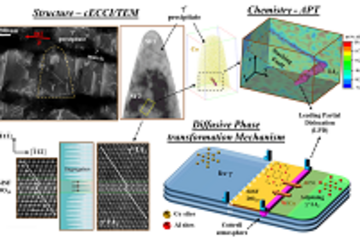All genres
81.
Talk
Activity and stability of water oxidation electrocatalysts in acidic media studied by SFC-ICPMS. 3rd Ertl Symposium on Surface Analysis and Dynamics
, Berlin, Germany (2014)
82.
Talk
Activity and stability of water oxidation electrocatalysts in acidic media studied by SFC-ICPMS. Electrochemistry 2014, Mainz, Germany (2014)
83.
Talk
Electrochemical CO2 reduction: A Combinatorial High-Throughput Approach for Catalytic Activity, Stability, and Selectivity Investigations. Electrochemistry 2014, Mainz, Germany (2014)
84.
Talk
Enhancing activity and stability of electrode materials for oxygen evolution by rational design of electrode morphology. 65th ISE Annual Meeting, Lausanne, Switzerland (2014)
85.
Talk
Electrochemical CO2 reduction: A Combinatorial High-Throughput Approach for Catalytic Activity, Stability, and Selectivity Investigations. 247th ACS National Meeting, Dallas, TX, USA (2014)
86.
Talk
Dissolution of Pt and the Consequences for Fuel Cell Operation. 97th Canadian Chemistry Conference and Exhibition, Vancouver, B. C., Canada (2014)
87.
Talk
In-situ investigation of Platinum Dissolution during Electrochemical Treatment by ICP-MS. 97th Canadian Chemistry Conference and Exhibition, Vancouver, B. C., Canada (2014)
88.
Talk
Dissolution of metals - Benchmarking stability for electrocatalytic water oxidation. 64th Annual Meeting of the International Society of Electrochemistry
, Santiago de Queretaro, Mexico (2013)
89.
Talk
Stability of Noble Metal Catalysts for Electrochemical Energy Conversion. GDCH-Wissenschaftsforum 2013, Darmstadt, Germany (2013)
90.
Talk
Electrochemistry vs. Dissolution - Coupling of a Scanning Flow Cell to Online Mass Spectrometry. 6th Kurt Schwabe Symposium, Krakow, Poland (2013)
91.
Talk
Coupling of electrochemistry and inductively plasma - Mass spectroscopy: Investigation of the noble metals corrosion. 59th International Conference on Analytical Sciences and Spectroscopy(ICASS)
, Mont-Tremblant, Canada (2013)
92.
Talk
Stability of Electrocatalyst Materials – A Limiting Factor for the Deployment of Electrochemical Energy Conversion? Third Russian-German Seminar on Catalysis “Bridging the Gap between Model and Real Catalysis. Energy-Related Catalysis”, Burduguz, Lake Baikal, Russia (2013)
93.
Talk
Dissolution of Pt during oxygen reduction in acidic media. GDCh-Wissenschaftsforum Chemie 2013, Darmstadt, Germany (2013)
94.
Talk
Investigation of platinum stability by in-situ mass spectrometry. 4th Regional Symposium on Electrochemistry South-East Europe, Ljubljana, Slovenia (2013)
95.
Talk
Rational design of morphological pattern for efficient electrocatalytic gas evolution. 4th Regional Symposium on Electrochemistry South-East Europe, Ljubljana, Slovenia (2013)
96.
Talk
E_ect of Cathodic Polarization on the Electrochemistry of Gold Surfaces. 63rd Annual Meeting of the International Society of Electrochemistry
, Prague, Czech Republic (2012)
97.
Poster
In-operando photocorrosion study on BiVO4 photoanodes. International Bunsen Discussion Meeting, Taormina, Italy (2019)
98.
Poster
Platinum dissolution in presence of chlorides. 3rd Ertl Symposium on Surface Analysis and Dynamics
, Berlin, Germany (2014)
99.
Poster
Dissolution of Noble Metals during Electrocatalysis of Oxygen Reduction and Oxygen Evolution. 65th Annual Meeting of the International Society of Electrochemistry
, Lausanne, Switzerland (2014)
100.
Poster
Electrochemical CO2 Reduction A Combinatorial High-Throughput Approach for Catalytic Activity, Stability and Selectivity Investigations. International Symposium on Electrocatalysis: Explorations of the Volcano Landscape, Whistler, BC, Canada (2014)











